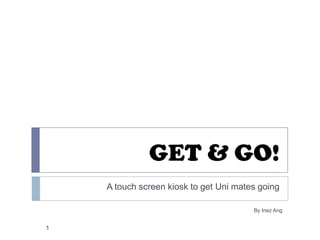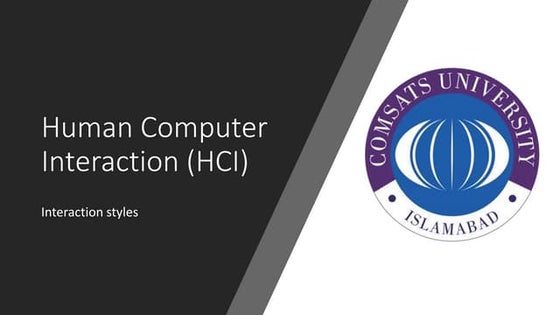Assignment5 Paper prototype
- 1. GET & GO! A touch screen kiosk to get Uni mates going By Inez Ang 1
- 2. USER INTERFACE -- Introduction Toggles between on- campus/off-campus mode Default toolbar (back, forward, bookmark, print, email, phone, help, search bar) Sub menu navigation buttons Touch QWERTY keyboard, automatically launches when keyboard input is needed. 2
- 3. USER INTERFACE -- Buttons 1 Each button has semi- opaque text describing details of the selection, allowing users more information at a glance. These buttons animate one at a time in an anti- clockwise order during inactivity, acting as a demo. Once activity is detected, the descriptive elements are static. 3
- 4. USER INTERFACE -- Buttons 2 Clicking on a button with a triangle icon launches a pull out menu with further options. A button with a pencil icon launches the QWERTY keyboard. 4
- 5. USER DEMO On Campus - Map Semi-opaque instructions will appear every time a new screen is loaded. It will disappear once the user begins interacting with the screen. Multiple search terms allow the user to input one or multiple criteria. Zoom bar allows user to minimize or maximum their view of the map. 5
- 6. USER DEMO On Campus - Map Selecting a search button displays a scrollable window with various search terms. Once a search term is selected, it is displayed in the search button. 6
- 7. USER DEMO On Campus - Map In this example, the user has chosen “Finance Office” from the “service” button. The map updates to highlight various buildings with finance offices and also displays the faculty name. The user can choose to narrow the search by specifying another search term. 7
- 8. USER DEMO On Campus - Map The resulting map is displayed showing a path from present location. Information included – Building name, Level and room, ETA (in minutes). 8
- 9. USER DEMO Print Selecting the print button sends a request to the built in printer. The map is printed onto an index-card sized sheet that the user can take away. 9
- 10. USER DEMO Print When printing is successful, a dialog box tells the user where to retrieve the printout. 10
- 11. USER DEMO On Campus - Map (room search) In another search example, a “building” has been selected from a scrollable menu. To enter a number, the user clicks on the “room ” button and the QWERTY keyboard automatically launches. A dialog box prompts the user. “X” allows the user to close the keyboard window. 11
- 12. USER DEMO On Campus - Map (room search) Once any search term has been entered, the map highlights related buildings and displays a path and a dialog box with requested information. 12
- 13. USER DEMO Email Clicking on the email icon launches a data entry window and QWERTY keyboard. Cancel closes the window, OK sends the email. 13
- 14. USER DEMO Email Notification that the email has been sent. OK closes the dialog box. Any error message will be displayed in the same format. 14
- 15. USER DEMO On campus - Activity Upon launching the page, a dialog box appears with instructions. Clicking anywhere else on the screen closes it. Today’s events are automatically displayed during launch. 15
- 16. USER DEMO On campus - Activity Date selector made bigger and simpler for touch screen interface. Select the field to change and press “+“ or “-”. Clicking on the forward arrow allows the user to set an end date. Back arrow will be highlighted during end date. 16
- 17. USER DEMO On campus - Activity Arrows allow users to move between dates. Back/forward arrows will highlight based on available content. The table can be sorted by columns. In ascending, the tip of the triangle will point upwards. The chosen column will also be highlighted. Translucent tips appear briefly to aid the user. 17
- 18. USER DEMO On campus - Activity Users can refine the search with another parameter. Reveals clubs in chosen alphabetical order 18
- 19. USER DEMO On campus - Transport Dialog box appears highlighting the search options for this page and directs them to another option should they need state-wide transport info. 19
- 20. USER DEMO On campus - Transport Destinations are listed in alphabetical order. Users can choose listing options. Users are also able to select if they want to travel by bus or train. 20
- 21. USER DEMO On campus - Transport A map stating the location of the alighting point, bus numbers, frequency, ETA and fare. 21
- 22. USER DEMO On campus - Transport Should they choose to retrieve the timetable of the train from Redfern station, a list appears with various timetables. Users can toggle between train lines. 22
- 23. USER DEMO Bookmark Selecting the “Bookmark” icon from the toolbar, a dialog box appears. Bookmarks are only saved for the day and prompts the user to consider other options if they want to permanently save the page. Selecting this highlights the PRINT/EMAIL/MMS options in the toolbar. 23
- 24. USER DEMO On campus - Discount Like in previous screens, a help dialog box appears when screen is launched. Displays specials of the day. 24
- 25. USER DEMO On campus - Discount Translucent tips appear briefly to aid the user. Discounts valid today are displayed. Clickable options 25
- 26. USER DEMO On campus - Discount When an option on the previous list is selected, a location map is displayed showing the details of the student discount. Jump to Off-Campus - Discount 26
- 27. USER DEMO MMS The map can be sent to the user’s mobile via MMS on selecting the option on the toolbar. Notification that charges will apply. QWERTY keyboard appears for phone number entry. 27
- 28. USER DEMO MMS Notification that MMS has been sent to specified phone number. 28
- 29. USER DEMO Off campus - Map/Activity/Transport In the OFF-CAMPUS mode, users can search websites for general information about Sydney. MAP – brings up maps.google.com.au ACTIVITY – brings up SydneyConnect.com TRANSPORT – brings up 131500.com QWERTY keyboard will be made Website is displayed in area marked X. available by clicking a launch button. Users can choose to touch selections or use the pen stylus 29 provided.
- 30. USER DEMO Off-campus - Jobs Help dialog box appears at the launch of the page. Background lists job applications closing this week. 30
- 31. USER DEMO Off-campus - Jobs Selection options in clickable categories grouped alphabetically. Location options are displayed in the same manner. 31
- 32. USER DEMO Off-campus - Jobs Job search results PRINT/EMAIL/MMS options are highlighted. 32
- 33. USER DEMO Off campus - Discount With the exception of an added “Movies” search option, this interface is similar to On-Campus Discount. Jump to On-Campus - Discount 33





































































